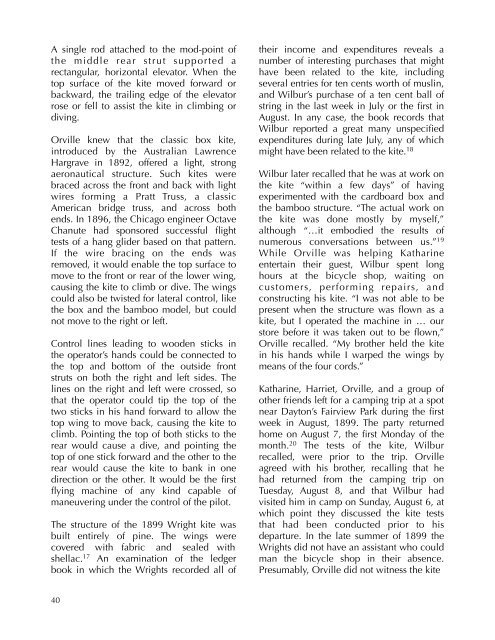You also want an ePaper? Increase the reach of your titles
YUMPU automatically turns print PDFs into web optimized ePapers that Google loves.
A single rod attached to the mod-point of<br />
the middle rear strut supported a<br />
rectangular, horizontal elevator. When the<br />
top surface of the kite moved forward or<br />
backward, the trailing edge of the elevator<br />
rose or fell to assist the kite in climbing or<br />
diving.<br />
Orville knew that the classic box kite,<br />
introduced by the Australian Lawrence<br />
Hargrave in 1892, offered a light, strong<br />
aeronautical structure. Such kites were<br />
braced across the front and back with light<br />
wires forming a Pratt Truss, a classic<br />
American bridge truss, and across both<br />
ends. In 1896, the Chicago engineer Octave<br />
Chanute had sponsored successful flight<br />
tests of a hang glider based on that pattern.<br />
If the wire bracing on the ends was<br />
removed, it would enable the top surface to<br />
move to the front or rear of the lower wing,<br />
causing the kite to climb or dive. The wings<br />
could also be twisted for lateral control, like<br />
the box and the bamboo model, but could<br />
not move to the right or left.<br />
Control lines leading to wooden sticks in<br />
the operator’s hands could be connected to<br />
the top and bottom of the outside front<br />
struts on both the right and left sides. The<br />
lines on the right and left were crossed, so<br />
that the operator could tip the top of the<br />
two sticks in his hand forward to allow the<br />
top wing to move back, causing the kite to<br />
climb. Pointing the top of both sticks to the<br />
rear would cause a dive, and pointing the<br />
top of one stick forward and the other to the<br />
rear would cause the kite to bank in one<br />
direction or the other. It would be the first<br />
flying machine of any kind capable of<br />
maneuvering under the control of the pilot.<br />
The structure of the 1899 Wright kite was<br />
built entirely of pine. The wings were<br />
covered with fabric and sealed with<br />
shellac. 17 An examination of the ledger<br />
book in which the Wrights recorded all of<br />
their income and expenditures reveals a<br />
number of interesting purchases that might<br />
have been related to the kite, including<br />
several entries for ten cents worth of muslin,<br />
and Wilbur’s purchase of a ten cent ball of<br />
string in the last week in July or the first in<br />
August. In any case, the book records that<br />
Wilbur reported a great many unspecified<br />
expenditures during late July, any of which<br />
might have been related to the kite. 18<br />
Wilbur later recalled that he was at work on<br />
the kite “within a few days” of having<br />
experimented with the cardboard box and<br />
the bamboo structure. “The actual work on<br />
the kite was done mostly by myself,”<br />
although “…it embodied the results of<br />
numerous conversations between us.” 19<br />
While Orville was helping Katharine<br />
entertain their guest, Wilbur spent long<br />
hours at the bicycle shop, waiting on<br />
customers, performing repairs, and<br />
constructing his kite. “I was not able to be<br />
present when the structure was flown as a<br />
kite, but I operated the machine in … our<br />
store before it was taken out to be flown,”<br />
Orville recalled. “My brother held the kite<br />
in his hands while I warped the wings by<br />
means of the four cords.”<br />
Katharine, Harriet, Orville, and a group of<br />
other friends left for a camping trip at a spot<br />
near Dayton’s Fairview Park during the first<br />
week in August, 1899. The party returned<br />
home on August 7, the first Monday of the<br />
month. 20 The tests of the kite, Wilbur<br />
recalled, were prior to the trip. Orville<br />
agreed with his brother, recalling that he<br />
had returned from the camping trip on<br />
Tuesday, August 8, and that Wilbur had<br />
visited him in camp on Sunday, August 6, at<br />
which point they discussed the kite tests<br />
that had been conducted prior to his<br />
departure. In the late summer of 1899 the<br />
Wrights did not have an assistant who could<br />
man the bicycle shop in their absence.<br />
Presumably, Orville did not witness the kite<br />
40


